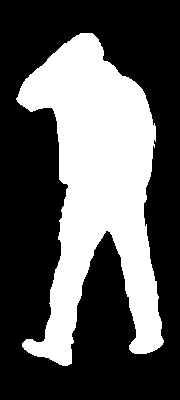【Python】 KerasでU-Net構造ネットワークによるセグメンテーションをする
ここ(Daimler Pedestrian Segmentation Benchmark)から取得できるデータセットを使って、写真から人を抽出するセグメンテーション問題を解いてみます。U-Netはここ( U-Net: Convolutional Networks for Biomedical Image Segmentation )で初めて発表された構造と思いますが、セグメンテーション問題にMax Poolingを使うのは良くないといった話があったり、Batch Normalization等も使いたいということで、pix2pixのGeneratorとして利用されているU-Net構造のネットワークを利用します。
実行環境は以下になります。
- Windows10 64bit
- Python3.5.2
- Keras2.0.4
- BackendはTensorflow CPU版
まずはU-Netモデルを作るクラスです(unet.py)。
#!/usr/bin/env python # -*- coding: utf-8 -*- from keras.models import Model from keras.layers import Input from keras.layers.convolutional import Conv2D, ZeroPadding2D, Conv2DTranspose from keras.layers.merge import concatenate from keras.layers import LeakyReLU, BatchNormalization, Activation, Dropout class UNet(object): def __init__(self, input_channel_count, output_channel_count, first_layer_filter_count): self.INPUT_IMAGE_SIZE = 256 self.CONCATENATE_AXIS = -1 self.CONV_FILTER_SIZE = 4 self.CONV_STRIDE = 2 self.CONV_PADDING = (1, 1) self.DECONV_FILTER_SIZE = 2 self.DECONV_STRIDE = 2 # (256 x 256 x input_channel_count) inputs = Input((self.INPUT_IMAGE_SIZE, self.INPUT_IMAGE_SIZE, input_channel_count)) # エンコーダーの作成 # (128 x 128 x N) enc1 = ZeroPadding2D(self.CONV_PADDING)(inputs) enc1 = Conv2D(first_layer_filter_count, self.CONV_FILTER_SIZE, strides=self.CONV_STRIDE)(enc1) # (64 x 64 x 2N) filter_count = first_layer_filter_count*2 enc2 = self._add_encoding_layer(filter_count, enc1) # (32 x 32 x 4N) filter_count = first_layer_filter_count*4 enc3 = self._add_encoding_layer(filter_count, enc2) # (16 x 16 x 8N) filter_count = first_layer_filter_count*8 enc4 = self._add_encoding_layer(filter_count, enc3) # (8 x 8 x 8N) enc5 = self._add_encoding_layer(filter_count, enc4) # (4 x 4 x 8N) enc6 = self._add_encoding_layer(filter_count, enc5) # (2 x 2 x 8N) enc7 = self._add_encoding_layer(filter_count, enc6) # (1 x 1 x 8N) enc8 = self._add_encoding_layer(filter_count, enc7) # デコーダーの作成 # (2 x 2 x 8N) dec1 = self._add_decoding_layer(filter_count, True, enc8) dec1 = concatenate([dec1, enc7], axis=self.CONCATENATE_AXIS) # (4 x 4 x 8N) dec2 = self._add_decoding_layer(filter_count, True, dec1) dec2 = concatenate([dec2, enc6], axis=self.CONCATENATE_AXIS) # (8 x 8 x 8N) dec3 = self._add_decoding_layer(filter_count, True, dec2) dec3 = concatenate([dec3, enc5], axis=self.CONCATENATE_AXIS) # (16 x 16 x 8N) dec4 = self._add_decoding_layer(filter_count, False, dec3) dec4 = concatenate([dec4, enc4], axis=self.CONCATENATE_AXIS) # (32 x 32 x 4N) filter_count = first_layer_filter_count*4 dec5 = self._add_decoding_layer(filter_count, False, dec4) dec5 = concatenate([dec5, enc3], axis=self.CONCATENATE_AXIS) # (64 x 64 x 2N) filter_count = first_layer_filter_count*2 dec6 = self._add_decoding_layer(filter_count, False, dec5) dec6 = concatenate([dec6, enc2], axis=self.CONCATENATE_AXIS) # (128 x 128 x N) filter_count = first_layer_filter_count dec7 = self._add_decoding_layer(filter_count, False, dec6) dec7 = concatenate([dec7, enc1], axis=self.CONCATENATE_AXIS) # (256 x 256 x output_channel_count) dec8 = Activation(activation='relu')(dec7) dec8 = Conv2DTranspose(output_channel_count, self.DECONV_FILTER_SIZE, strides=self.DECONV_STRIDE)(dec8) dec8 = Activation(activation='sigmoid')(dec8) self.UNET = Model(input=inputs, output=dec8) def _add_encoding_layer(self, filter_count, sequence): new_sequence = LeakyReLU(0.2)(sequence) new_sequence = ZeroPadding2D(self.CONV_PADDING)(new_sequence) new_sequence = Conv2D(filter_count, self.CONV_FILTER_SIZE, strides=self.CONV_STRIDE)(new_sequence) new_sequence = BatchNormalization()(new_sequence) return new_sequence def _add_decoding_layer(self, filter_count, add_drop_layer, sequence): new_sequence = Activation(activation='relu')(sequence) new_sequence = Conv2DTranspose(filter_count, self.DECONV_FILTER_SIZE, strides=self.DECONV_STRIDE, kernel_initializer='he_uniform')(new_sequence) new_sequence = BatchNormalization()(new_sequence) if add_drop_layer: new_sequence = Dropout(0.5)(new_sequence) return new_sequence def get_model(self): return self.UNET
次に前処理関連の関数です(main.py)。
IMAGE_SIZE = 256 # 値を-1から1に正規化する関数 def normalize_x(image): image = image/127.5 - 1 return image # 値を0から1に正規化する関数 def normalize_y(image): image = image/255 return image # 値を0から255に戻す関数 def denormalize_y(image): image = image*255 return image # インプット画像を読み込む関数 def load_X(folder_path): import os, cv2 image_files = os.listdir(folder_path) image_files.sort() images = np.zeros((len(image_files), IMAGE_SIZE, IMAGE_SIZE, 3), np.float32) for i, image_file in enumerate(image_files): image = cv2.imread(folder_path + os.sep + image_file) image = cv2.resize(image, (IMAGE_SIZE, IMAGE_SIZE)) images[i] = normalize_x(image) return images, image_files # ラベル画像を読み込む関数 def load_Y(folder_path): import os, cv2 image_files = os.listdir(folder_path) image_files.sort() images = np.zeros((len(image_files), IMAGE_SIZE, IMAGE_SIZE, 1), np.float32) for i, image_file in enumerate(image_files): image = cv2.imread(folder_path + os.sep + image_file, cv2.IMREAD_GRAYSCALE) image = cv2.resize(image, (IMAGE_SIZE, IMAGE_SIZE)) image = image[:, :, np.newaxis] images[i] = normalize_y(image) return images
最後にこれらを利用するメイン関数です(main.py)。これを動作させるためには以下のファイル/フォルダ構造を想定しています。 - main.py - unet.py - trainingData(トレーニング用データを格納するフォルダ) - testData(テスト用データを格納するフォルダ) 更にtrainingDataフォルダ、testDataフォルダには最初に紹介したデータセットにあるleft_imagesフォルダとleft_groundTruthフォルダがそれぞれ置かれているものとします。
- 2017/08/10 関数predictのモデル生成部の不具合を修正
- 2017/11/08 import osを書き忘れている不具合を修正
import os import numpy as np from keras.optimizers import Adam import keras.backend as K from keras.callbacks import ModelCheckpoint, EarlyStopping from unet import UNet # ダイス係数を計算する関数 def dice_coef(y_true, y_pred): y_true = K.flatten(y_true) y_pred = K.flatten(y_pred) intersection = K.sum(y_true * y_pred) return 2.0 * intersection / (K.sum(y_true) + K.sum(y_pred) + 1) # ロス関数 def dice_coef_loss(y_true, y_pred): return 1.0 - dice_coef(y_true, y_pred) # U-Netのトレーニングを実行する関数 def train_unet(): # trainingDataフォルダ配下にleft_imagesフォルダを置いている X_train, file_names = load_X('trainingData' + os.sep + 'left_images') # trainingDataフォルダ配下にleft_groundTruthフォルダを置いている Y_train = load_Y('trainingData' + os.sep + 'left_groundTruth') # 入力はBGR3チャンネル input_channel_count = 3 # 出力はグレースケール1チャンネル output_channel_count = 1 # 一番初めのConvolutionフィルタ枚数は64 first_layer_filter_count = 64 # U-Netの生成 network = UNet(input_channel_count, output_channel_count, first_layer_filter_count) model = network.get_model() model.compile(loss=dice_coef_loss, optimizer=Adam(), metrics=[dice_coef]) BATCH_SIZE = 12 # 20エポック回せば十分 NUM_EPOCH = 20 history = model.fit(X_train, Y_train, batch_size=BATCH_SIZE, epochs=NUM_EPOCH, verbose=1) model.save_weights('unet_weights.hdf5') # 学習後のU-Netによる予測を行う関数 def predict(): import cv2 # testDataフォルダ配下にleft_imagesフォルダを置いている X_test, file_names = load_X('testData' + os.sep + 'left_images') input_channel_count = 3 output_channel_count = 1 first_layer_filter_count = 64 network = UNet(input_channel_count, output_channel_count, first_layer_filter_count) model = network.get_model() model.load_weights('unet_weights.hdf5') BATCH_SIZE = 12 Y_pred = model.predict(X_test, BATCH_SIZE) for i, y in enumerate(Y_pred): # testDataフォルダ配下にleft_imagesフォルダを置いている img = cv2.imread('testData' + os.sep + 'left_images' + os.sep + file_names[i]) y = cv2.resize(y, (img.shape[1], img.shape[0])) cv2.imwrite('prediction' + str(i) + '.png', denormalize_y(y)) if __name__ == '__main__': train_unet() predict()
上手く抽出出来ている例(元画像/正解画像/予測画像)









上手くいかなかった例(元画像/正解画像/予測画像)









上手くいっていない例を見ると、学習データに類似パターンが無さそうなケースでした。学習していないことを予測できないのは仕方無いので、学習用データに十分なバリエーションを持たせて学習させることが重要と思いました。